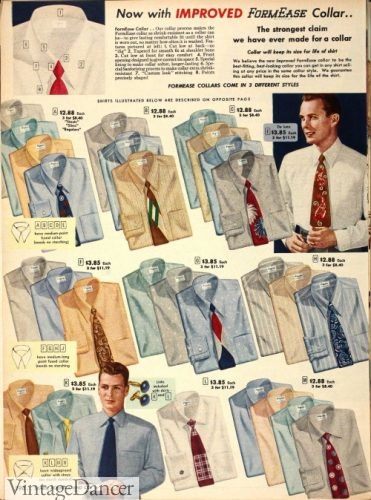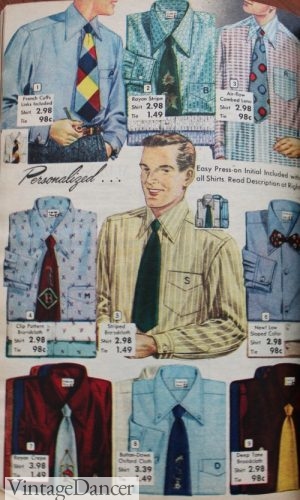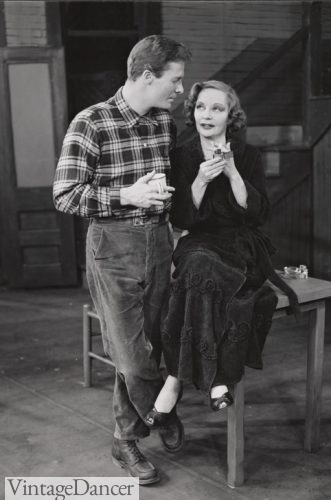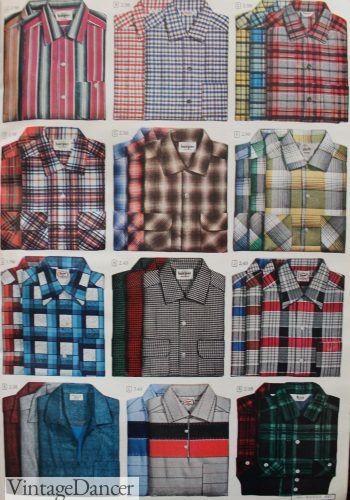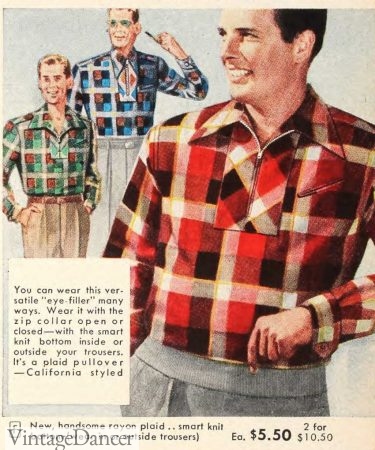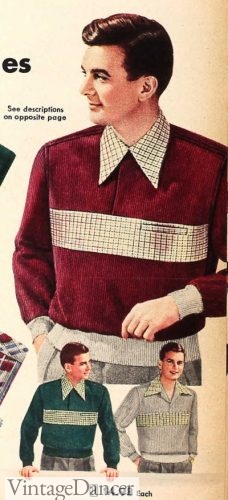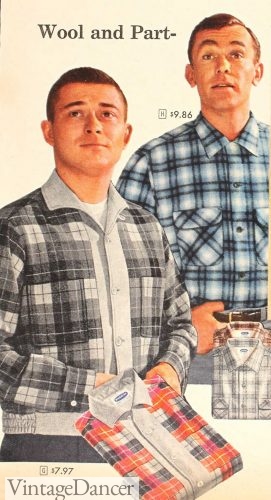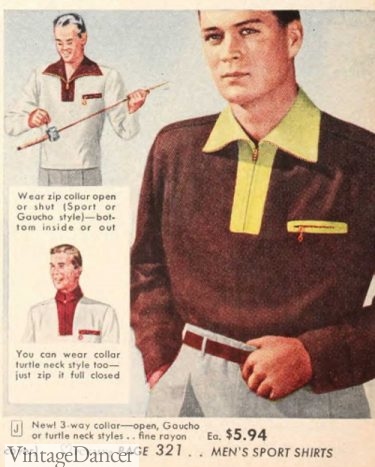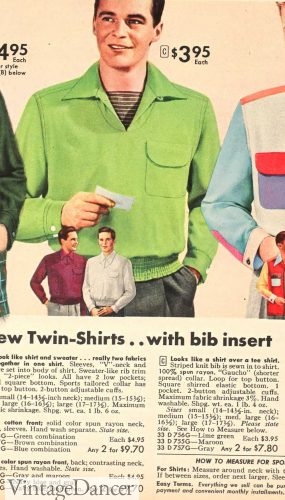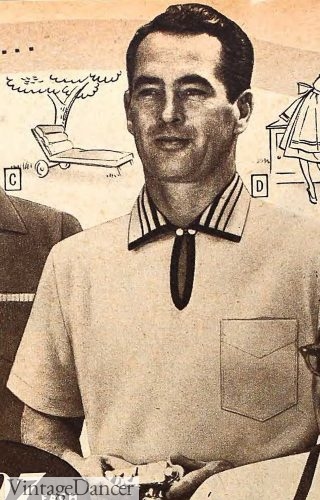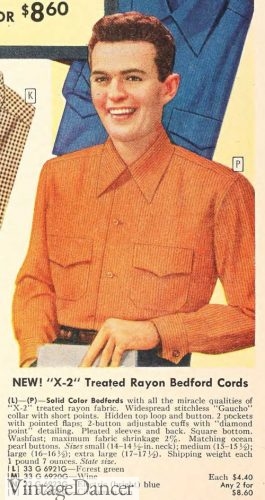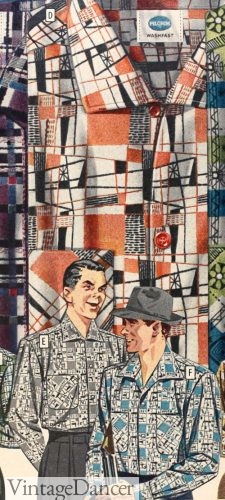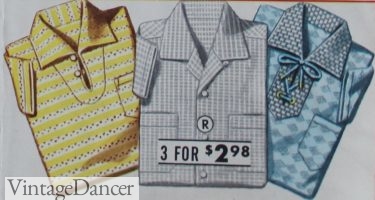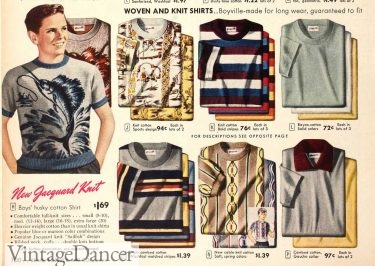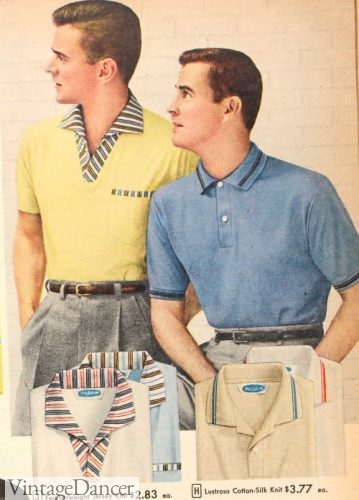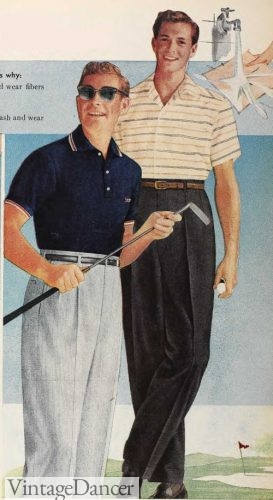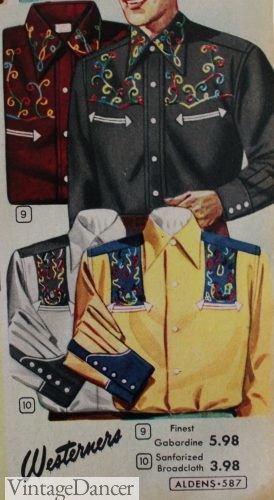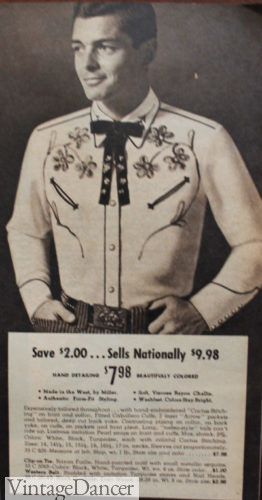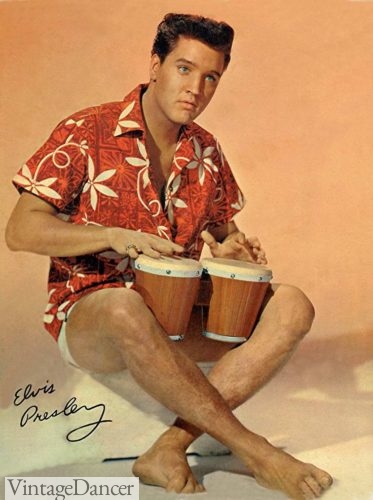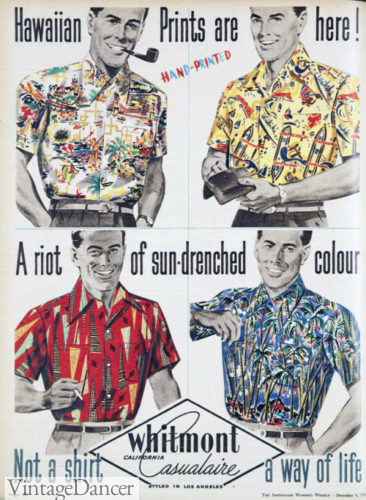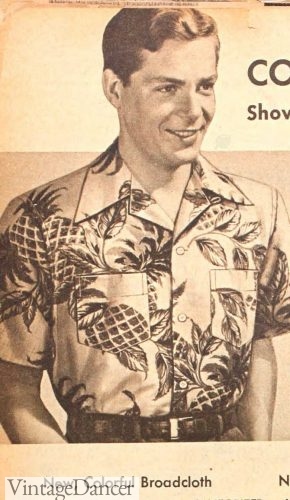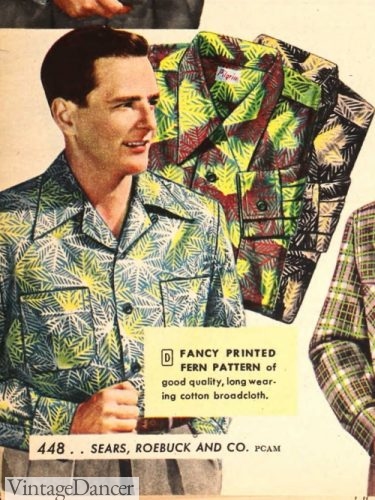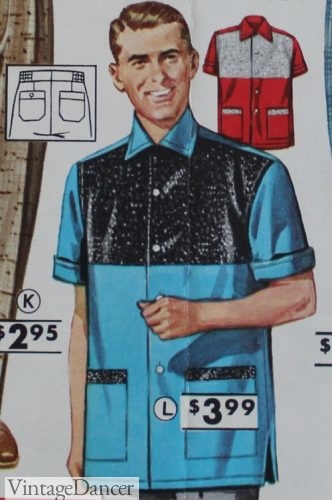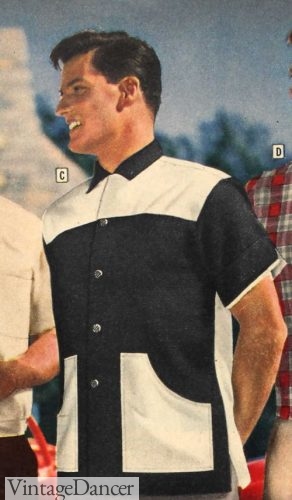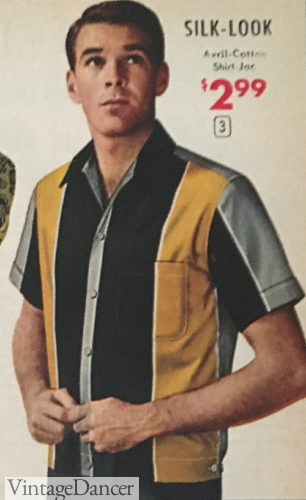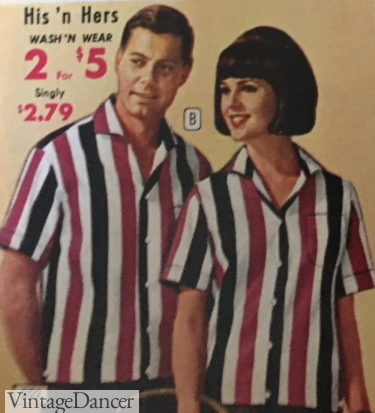1950s men’s fashion has returned to modern wardrobes this year. 1950s men’s shirts in particular seem to always get the biggest revival. Dress shirts, button down casuals, polo shirts, even retro T-shirts all have their place both in the vintage retro market and in our current everyday fashion. There are many more styles beyond the classic 1950s camp or bowling shirts, Hawaiian shirts, and flannel shirts.
I didn’t realize just how many different styles of men’s ’50s shirts there were until I began research for this article. I think you, too, will find the history of 1950s men’s shirts an interesting study.
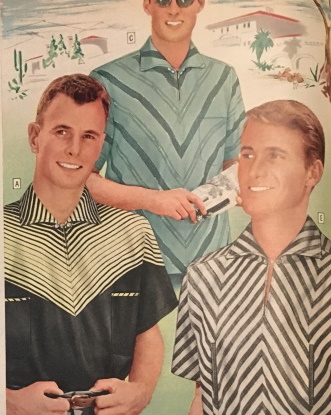
1957 gaucho shirts
1950s Men’s Dress Shirts
The trend for more colors, lighter materials, and a casual, comfortable style was reflected in men’s dress shirts in the 1950s. For the most part stiff, wide, long collars that needed collar pins to hold them in place were gone. The new types of collars were shorter, straighter, and usually didn’t need additional accessories. The length of collars is similar to today’s men’s dress shirts, or a tad longer. The button down collar became very trendy as a neat way to keep collars in place without severe starching or collar pins. There was a brief resurgence of round (AKA club or penny collars) too.
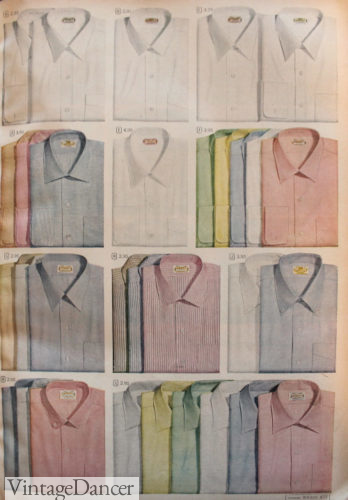
1955 men’s dress shirts with spread collars, pointed collars, and button-down penny collars in white, light pastels and stripes
Dress shirt collars came in everything beyond basic white and blue, like fancy checks, plaids, and small patterns – all similar to those found in men’s sport shirts. Materials featured more cloth with an open, breathable weave. The difference between dress and sport was still in the tailoring and the fancy collar types.
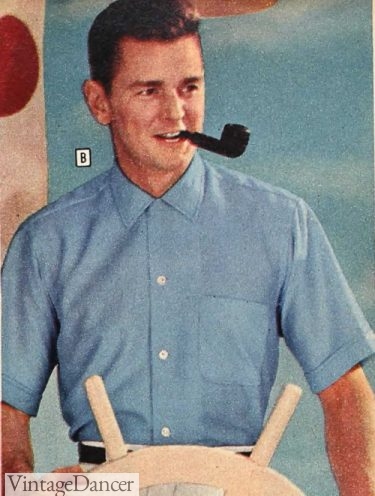
1958 short sleeve dress shirts could also be casual shirts when worn without a tie
When the short sleeve dress shirt hit the market around 1953, retailers feared they would look too much like sport shirts. Educating the salesmen to show off the new style as a cooler alternative to long sleeves was required. Fortunately, most male shoppers picked up the trendy short sleeved style with enthusiasm. Now they could relax in their offices in casual comfort and still look respectable when the need came to put their suit jackets back on.
- 1950 Men’s Tropical Dress Shirts
- 1953 Men’s Dress Shirts in Very Bold Patterns
There were two styles for men in the ’50s. The traditional Ivy look with narrow, straight point collar and thin tie (think Don Draper in early Mad Men) and the new Continental look, inspired by Italian tailoring, which featured wider spread collars to accommodate wide tie knots like the Windsor. Both styles came with one and sometimes two chest pockets.
Continental shirts came in more tropical colors such as Melon, Tangerine, Granada green, and Malacca yellow. Some shirts even came in small prints similar to patterns of a Macclesfield tie. The young men were first to pick up on the Continental trend with the rest of the casual seeking ’50s men to follow.
More about men’s 1950s dress shirts.

1957 men’s traditional and contemporary dress shirts
1950s Men’s Casual Shirts
While dress shirts in the early 1950s eventually got some color diversity, the sport shirts were always colorful. It was a welcome break from the humdrum “grey flannel suit” of the early conservative ’50s. Weekends and afternoons after work were a time for men to match their wives and look like tourists on a tropical vacation.
1950s men’s casual shirts called sport shirts were made of knit or pre-shrunk cotton and synthetic fabrics that washed and wore easily. “No ironing needed” was a big selling point, mostly for house wives who were the primary purchasers of men’s shirts.
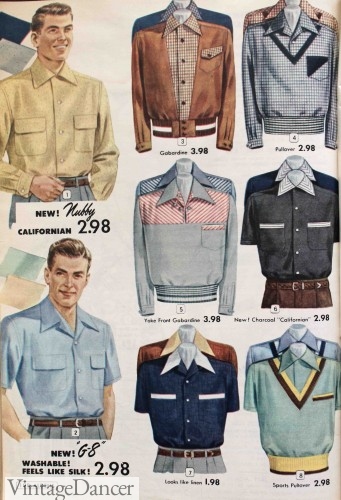
A mix of sport knits, button downs, and pullover shirts
Unlike the ’20s to the ’40s, there was a wide variety of sport clothes. Previously, sport shirts consisted of unbuttoned dress shirts and some knit shirts. The 1950s took casual men’s shirts to new places with new colors, new styles and some outlandish prints!
Men’s 1950s Button Down Shirt
The button down shirt was a spin off from men’s dress shirts. They had one or two chest pockets, were worn tucked in, and had a moderate point collar. These were the majority of men’s casual shirts, offered in a variety of vertical stripes, horizontal stripes, plaid, checks, windowpane as well as solid colors in pastels or winter-tones. Most shirts pockets had simple flaps but scalloped western style flaps were found on some as well as pleated pockets, simple button down pockets, and plain pockets.
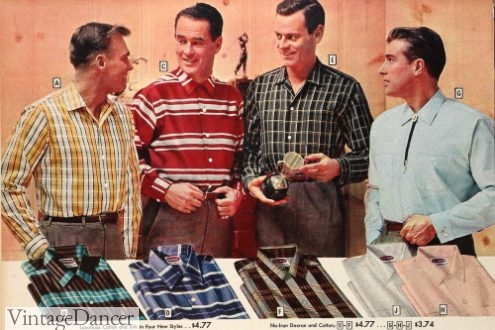
1957 button down shirts
Most shirt collars buttoned up to the neck just like dress shirts. Initially men’s sport shirts featured wide fold out collars that could also be button up to resemble dress shirt collars. As the decade moved on shorter and smaller collars replaced most of the large collars.
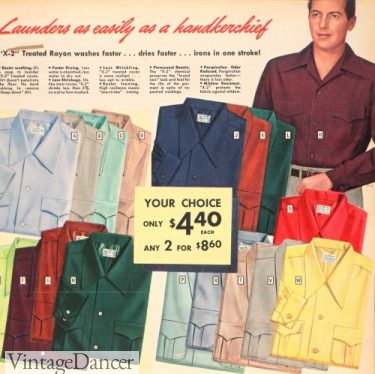
1952 casual shirts, large collars, with two pockets- many colors
Shirt materials were cotton, wool, terry cloth, rayon “gabardine”, silk, madras, flannel, corduroy, crinkle crepe, and synthetics such as acetate, Orlon, and Dracon. In the early 50s the lustrous rayon “gab” was the best shirt to own. Popular new colors were Kelley green, gold, spice brown, teal and light pink.
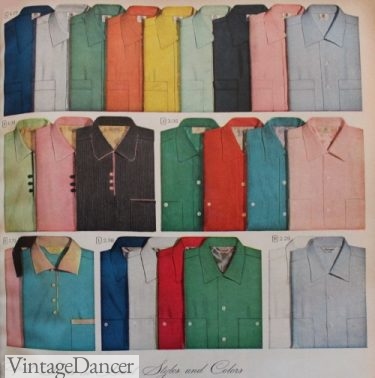
1955 casual shirt, small collars, rainbow of colors
In the mid 50s color brighten up considerably with even more hot pink, lime green, purple, turquoise blue, salmon, yellow, coral and sky blue. Combining these colors with black trim, striped panels, collars, buttons, cuffs created a new California style (inspired by Italian designers) that is especially collectable today. Pink or purple with contrasted grey was another popular two tone shirt.
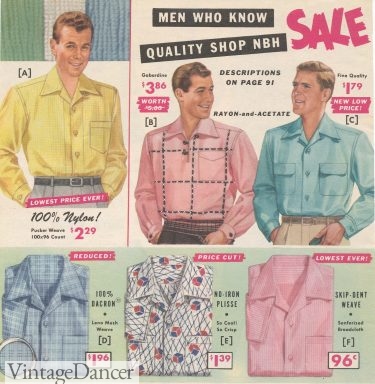
1955 bright sport shirts
In fall and winter, a long sleeve plaid flannel shirt (aka a country or California ranch look) was especially popular. Plaid shirts were still common in short sleeve versions for summer, too. Vertical or horizontal stripes and solid colors were also popular but plaid ruled the decade.
Since pants were always solid colors, a patterned shirt was a welcome vibrant contrast. There was no limit to colors and color combinations in the ’50s. They were MUCH more bold than today’s color selection.
- 1958 Fred Beir wears a plaid shirt
- 1951 Men’s Plaid Shirts
Banded Bottom Shirts
One particular style of button down shirt took inspiration from men’s casual jackets and placed a knit band along the bottom. Later styles replaced the knit band with a elastic gathered band. The body of the shirt button down or pulled overhead, had a variety of sport collars, and came in plain but more often plaids, wide chest stripes and checks. Cuffs could be knit or button tab cuffs. They were usually worn over trousers just below the waistband, but could be tucked in too which made them look like any other sport shirt.
- 1950 plaid pullover banded bottom shirt
- 1951 pullover banded hem shirt
- 1959 plaid banded hem shirts
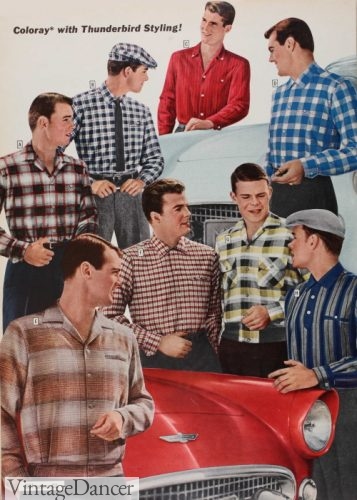
1957 men’s banded bottom shirts
Some button-up shirts combined a shirt jacket and button-down shirt into one style but without the banded hem. The shirt-jacket came in plaid or western-inspired motifs. They were often made of wool or gabardine fabric, a common lightweight jacket material. They were designed to be worn alone but some men layered them over casual T shirts or undershirts. Today these have been renamed shackets.
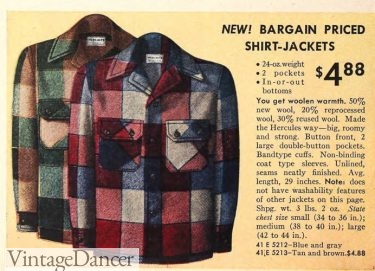
1950 plaid shirt-jackets
Gaucho Shirts
Pullover shirts, slipover shirts, or popover shirts are all names for another style of 1950s men’s casual shirt that lacked the button down front. Pullover shirts often had a banded bottom but could be loose and had interesting collar styles. The most famous of these collar types is the Gaucho collar which was a spread collar worn open or button under with a loop or zipper. When worn open another shirt could be visible underneath or an insert of fabric was attached to resemble a layer shirt, a look called the “twin shirt.”
Gaucho collars initially were wide spread but turned into small spread collars by 1955. The gaucho name is often applied to any style of pullover shirt with an open collar.
- 1950 Gaucho collar worn 3 ways- open, zip up and turtleneck
- 1951 Gaucho collar shirt with “Twin” insert
- 1955 mens gaucho collar shirt
- 1952 wide spread gaucho buttoned up
Another pullover shirt unique to the 1950s was the Cumpari shirt. It too had a small but wide spread collar but no button placket. The shirt body fit right at the neck sometimes with two decorative buttons. It somewhat resembled a Western shirt with a yoke front.
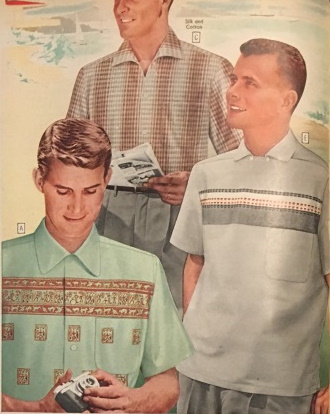
1957 mens casual shirts- Cumpari style on the right
Other sport collars were the Continental point collar, Continental roll collar, short point, bullnose, sharkfin, curved collar, lace up, loop button up and Italian collar. These collars were applied to all kids of men’s casual shirts in both flat cotton and knitwear as well as many sweatshirts and jackets.
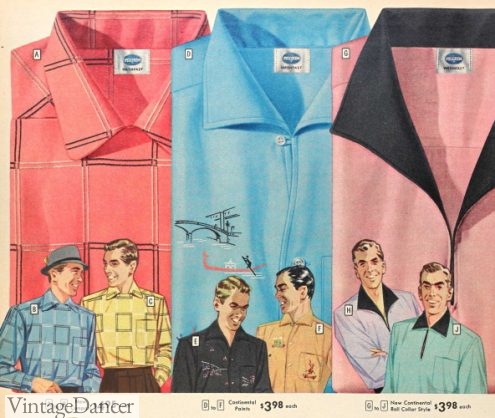
1955 mens two tone men fun summer shirts cumpari collar, continental points collar, roll collar shirts
- 1955 continental roll collar shirts (Italian design prints)
- 1958 loop collar, small camp collar shirts and lace up collars
Men’s 1950s Knit Shirts and T-Shirts
A sporty and youthful alternative to the classic button down shirt was the snug fitting knit shirt. It had its roots back to the 1920s, with little change in the overall shape through the ’60s. A high round rib collar matched a wide rib band that was worn tucked inside or layered outside of trousers, and around the waist. A narrow rib sleeve band was also common, although the new “T Shirt” variety had a simple stitched sleeve and an open waist.
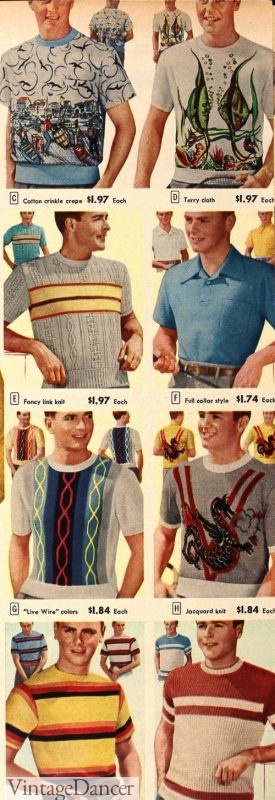
1951 men’s knit shirt
The new late 1940s and early 1950s fad was for knits to be woven with fancy designs of Americana life – cars, tropical vacations, sports, and exotic women (tasteful). They also added in Western and Hawaiian shirt design elements on some styles. Knit shirts with wide stripes, geometric patterns, chain links and color-blocking were all common patterns. Most were a medium or heavy knit with additional ribbed, cable, mesh and other textured stitches.
- 1952 knit shirts
- 1959 knit shirts
The white T shirt or undershirt, made common in the 1940s during WWII, was not well advertised as a sport shirt. It was designed for active sportswear and to be worn under a sport shirt, never by itself in public company. It was, after all, initially a part of men’s underwear. Flat knit smooth tee shirts were usually solid colors or horizontal stripes.
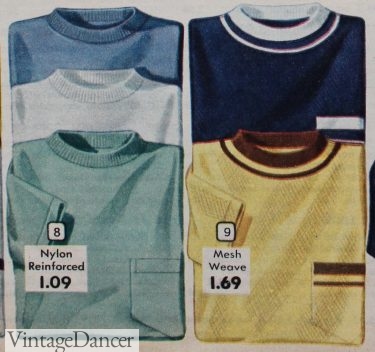
Marlon Brando gave the T-shirt its public debut in the 1951 movie, A Streetcar Named Desire, and again in the 1954 movie, The Wild One. Fellow actors James Dean and Elvis Presley also wore the look in the 1950s. The T-shirt and jacket look (usually leather jackets) became a fashion fad among high school youth. These young rebels always wore white T-shirts (as tight fitting as possible) and dark denim jeans, rolled at the cuff.
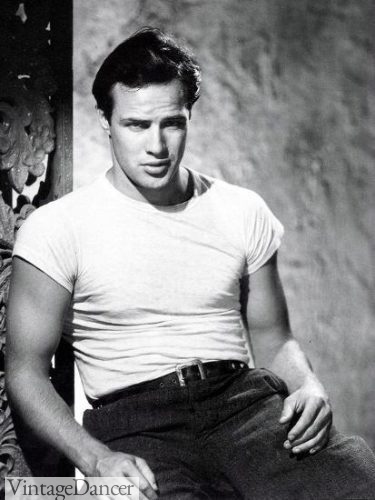
1951 white tee shirt worn by Marlon Brando in A Street Car Named Desire
Post-rebellious age men enjoyed the snug fit of the T shirt, which showed off their muscular physique. They did not, however, wear white. A solid color T-shirt with contrasting rib neckband and single chest pocket was about as casual as they would wear a T-shirt. Most 50s tee shirts featured a short 1/4 to 1/2 sleeve and barrel body (no side seams.) The V neck shirt wasn’t common, but available, as was the sleeveless top in the later 1950s. Learn more about T shirt and gym wear.
The lack of good ‘ink printing’ kept T-shirts plain throughout the ’50s. By the end of the decade, a flocked school letter was added to most college sport tee shirts. That was it for decoration, until the printing processes were improved in later decades.
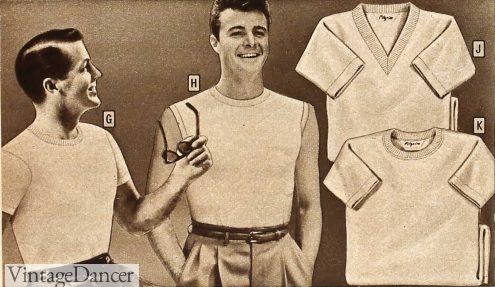
1957 men’s T-shirts: crew, sleeveless, V neck
A knit shirt with knit collar is often called a “polo shirt” today although that name wasn’t very common in the 50s. Some polos had open collars (not buttons) with contesting fabrics (plain or pattern.) Contrasting lines on the collar and sleeve cuffs were also common, just as they are now. Golfers liked simple polo shirts in bright summer pastel colors or very bold and classic golf patterns such as argyle.
In the early 1950s terry cloth was used for all kinds of casual shirts, especially the polo shirt or knit pullover shirt.
- 1957 Polo Shirts
- 1958 Classic Golf Outfit with Polo Shirts
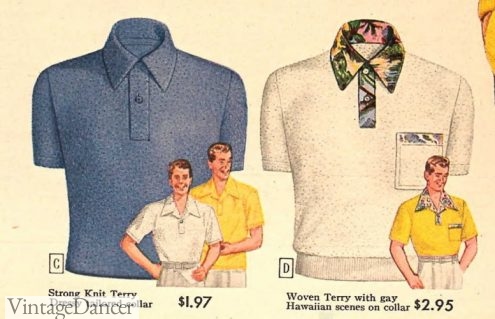
1952 terry cloth polo shirts
1950s Men’s Western Shirt
The 1940s and 1950s were obsessed with American Western life. Ranching, horses, campfires, and singing folk songs were all part of a spirit of American pride. The singing movie cowboys of the 1950s such as Roy Rogers or Clayton Moore‘s Lone Ranger introduced a new western look to the masses.
- 1953 Western Shirts
- 1957 men’s Western dress shirt with tie
Young boys in the 1940s grew into men who still wanted to be just like Roy Rogers in the 1950s. The western shirt became the best way to wear the cowboy fashion. Button down shirts, knit shirts, jackets, and some pants featured elaborate bib and yokes, contrast piping, “western prints”, two tone colorblocking, embroidered roses/flowers/scrolls and fringe. An bolo tie or string tie was frequently worn with western or any casual button down shirt.
Fancy Western dress shirts had mother of pearl buttons too! Most shirts had three snap button cuffs but the five snap button called a Caballero cuff was extra stylish.
Pocket styling was also unique: darts, flaps, saddle bag, and two-point Arizona wing pockets.
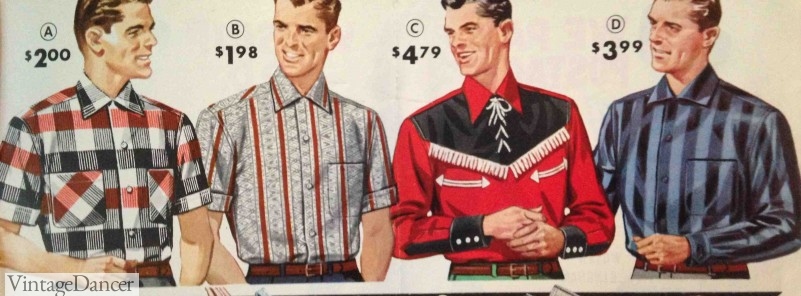
1958 Men’s Button-Down Shirts, large prints, and Western
Men’s 1950s Hawaiian Shirt
Another form of button down shirt, these were not worn tucked in. Its collar also did not button all the way up, but was left open so the large point collar could lay flat. It came by many names – Camp shirt, beach shirt, Cabana shirt, and Hawaiian shirt. They were the ultimate in casual, pool or beach-side wear.
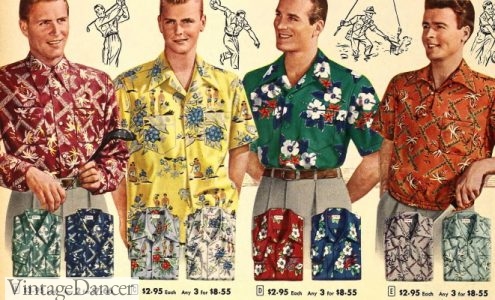
1951 men’s Hawaiian shirts
Since pool parties or “Tiki” parties were extremely popular house party themes, it was the ideal shirt to wear in the summer. They came in solid colors as well as vivid prints depicting American life, tropical inspired motifs, sporting scenes, and cars. Authentic “Aloha” shirts are made in Hawaii, often with coconut or wood buttons. They were expensive to buy in the ’50s, but there were plenty of knock offs that gave men the same tropical look.
- Elvis sporting a red Hawaiian print shirt
- 1951 men’s Tropical or Hawaiian casual shirts (worn tucked in)
- 1952 pineapple tropical shirt
- 1952 tropical fern print shirts
Besides Hawaiian or tropical prints there were Mexican and African themes and other vacation destinations and their inspired folk art. They came in both classic point collars and sporty camp collars. Hawaiian shirts are the most widely worn style of 1950s men’s shirt today. They are easy to find, fun to outfit, and usually not very “costume-y” looking.
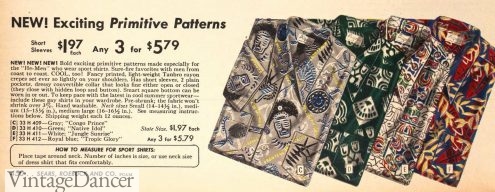
“Primitive pattern” shirts
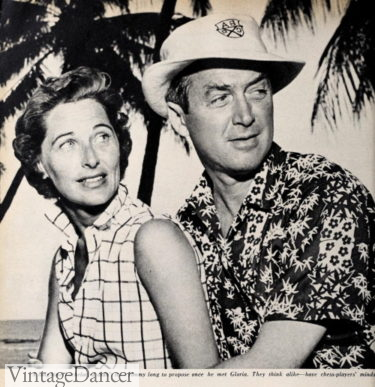
1955 James Stewart and Gloria
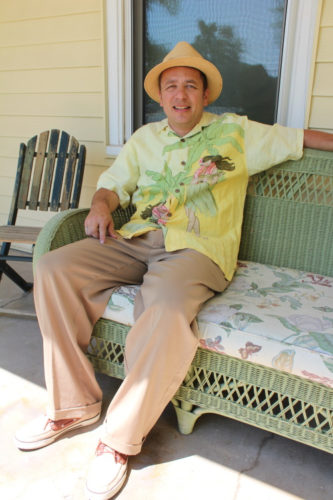
My Hawaiian hula girl linen shirt
Bowling Shirts
The ’50s “bowling shirt” encompasses the same style as the camp or Hawaiian shirt, but with funny team names and a team embroidered logo. I don’t think men wore these except for when bowling in the ’50s, but that is certainly not the case today.
What usually earmarks a bowing shirt is to two tone colorblock patterns, both vertical and horizontal wide panels, and button down front with loose hem. In the mainstream, bowling shirts changed to small collars, rolled sleeves, and added large patch pockets. The vertical panel shirt would take a few more years before it went mainstream in the mid 1960s.
- 1958 bowling shirt style
- 1959 colorblock shirt
- 1965 mens bowling shirt
- 1965 striped couple’s bowling shirts
Shop Men’s 1950s Shirts
Search this list of vintage reproduction clothing brands and you will find a plethora of men’s ’50s shirts in the camp/bowling shirt style. For fun and customizable bowling shirts, try bowlingshirt.com. Hawaiian shirts can be found anytime during the summer.
For a classic button down shirt, you can wear a modern dress shirt IF you can find one with two pockets (not easy). Pocket-less shirts are more common today, but they don’t look ’50s enough. Knit shirts? Even harder to find, but are coming back in style in 2020. A modern polo shirt with a bold pattern can look ’50s enough for most uses.
Buy 1950s style men’s shirts here
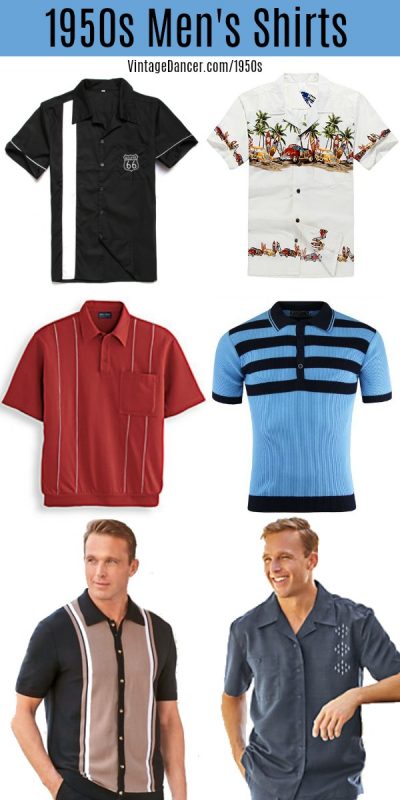
1950s men’s best selling shirts. Buy now.
Debbie Sessions has been teaching fashion history and helping people dress for vintage themed events since 2009. She has turned a hobby into VintageDancer.com with hundreds of well researched articles and hand picked links to vintage inspired clothing online. She aims to make dressing accurately (or not) an affordable option for all. Oh, and she dances too.
